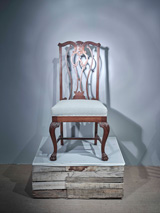STRUCTURAL FEATURES: This side chair has a solid, elegant construction, intrinsic to furniture of the Georgian era (1714-1830). More specicially, this chair evokes the Chippendale style, which derives its name from the work of the eminent English furniture designer Thomas Chippendale. Thanks in part to his book The Gentleman and Cabinet-Maker’s Director (1754), Chippendale built a thriving furniture business in the mid-18th century supplying aristocrats and elites, with numerous other craftsmen adopting and refashioning Chippendale designs to their own ends. The style proved popular in Calcutta in the late-18th century, and inspired numerous modern pieces more recently. One re-interpretation of the Chippendale syles was commissioned by an ex-Viceroy of India, Rufus Daniel Issacs in the early 1920s.
STYLISTIC FEATURES: An interpretation of the French Rococo style of furniture which was adopted by Chippendale himself, the chair has a yoke-shaped toprail, a pierced vertical backslat with sharply carved foliate scrolls, and an upholstered seat raised on finely structured legs. While the front legs of the chair are of the lion's feet design -- a type of cabriole design -- the rear legs, of the Marlborough style, terminating in a block foot, are devoid of any elaborately carved elements.



CABRIOLE-LEG CHAIR
DESIGNER: Unknown
MATERIAL: Wood with upholstered seat
STYLISTIC INFLUENCE: Anglo-Indian
DESIGNER: Unknown
MATERIAL: Wood with upholstered seat
STYLISTIC INFLUENCE: Anglo-Indian

